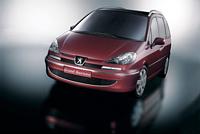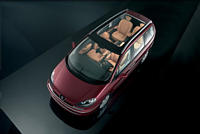Peugeot concept cars in Geneva
CLICK4MORE FROM AUTOINDEX.ORG
THE HOGGAR, A CONCEPT CAR Resembling an imposing 2-seater buggy, the Peugeot Hoggar looks avant-garde and unreal at first sight. Vast open spaces spring to mind, easily accessible to judge from the car’s robustness and latent power. Getting there would be an even more pleasing and relaxing prospect in the knowledge that this concept car relies on unique and proven HDi engineering solutions, enhanced by original technology, such as the adoption of two power trains and appropriate wheels and suspension. Rest assured that far-flung destinations are also well within reach, since this 2-seater Diesel HDi has a great range, as well as particulate emission filters that make it environmentally friendly like other models in the Peugeot range.
THE STYLE In elevation, the Hoggar has no overhang, thereby offering a highly compact volume with condensed proportions. The front wing rises over the tyre and falls back gently, before rising again abruptly at the rear wheel. This creates a general profile that is both elegant and dynamic and which, combined with the rear projection, expresses the strength and robustness of a crouching animal ready to pounce.
Following the example of the RC Diamonds and RC Spades, the bonnet’s front end envelops the grille, which houses the lion badge of the marque. Its rear end extends into the passenger compartment by means of dual, rounded sections that pass through the windscreen and culminate in two instrument panels. The cat-like headlamps resemble half-closed but watchful eyes, while at the rear a sinewy impression is created, reinforcing the animal nature of the Hoggar, ready to leap from dune to dune.
ENGINEERING The Hoggar is a sports car for extreme conditions, with two seats and two up to the minute power trains deployed transversally, one at the front, the other at the rear, giving it the attributes of a 4-wheel drive vehicle. The car consists principally of a one-piece carbon honeycomb shell reinforced by two upper longitudinal roll-over bars made from stainless steel, each with a diameter of 76 mm. These tubes also serve as an air intake and air conduit to the front engine (left-hand tube) and rear engine (right-hand tube). At the front of the carbon structure, as at the rear, there is a tubular sub-frame designed to support each power train. Attached to the carbon shell at six points at the front and four at the rear, these tubular frames also accommodate all suspension fittings, including the double wishbones.
Each power train incorporates the same turbocharged fourcylinder Diesel HDi engine with dual overhead camshaft and sixteen valves. Their displacement is 2168 cm3 and their maximum power 133 kW. The two engines therefore supply a combined power of 266 kW or nearly 360 bhp and a maximum torque of 800 Nm. Each engine’s exhaust line has a catalytic converter, a particulate emission filter (PEF) and a silencer. The left-hand line corresponds to the front engine, while the right-hand line corresponds to the rear engine. Each power train has its own electronics. A global electronic control unit (the supervisor) distributes instructions to both engines from a single accelerator pedal and a single gearbox control. Two separate fuel tanks each with a capacity of 80 liter give the vehicle a considerable range in view of the low fuel consumption of the HDi engines. Each ML 6C gearbox is driven by electrically-controlled hydraulic actuators. The sequential gear change operates by means of control plates under the steering wheel or a lever on the central console. A fully automatic mode is also available. The Hoggar can of course be driven with only one of its two power trains. The suspension of this concept car features double wishbones at the front and rear. Each axle is equipped with an anti-roll bar. The light-alloy wishbones allow generous clearance both in terms of compression (250 mm) and expansion (250 mm). To guarantee steering accuracy despite a total travel of 500 mm, each front suspension unit has a decoupled pivot. The four suspension units are fitted with two spring/gas damper units, each equipped with a gas reservoir. This additional capacity makes it possible to increase the volume of available gas while retaining a compact damper body. Assisted braking is provided by four ventilated discs and six-piston brake calipers. The 21’’ diameter light-alloy wheels have original styling. They are fitted with Michelin tyres, with a design which matches that of the wheel.
EQUIPMENT On board this ultra high-tech open-air vehicle, natural leather and aluminium feature strongly. Two people can sit in the one-piece, cast light-alloy seats, which have leather upholstery. Each occupant is secured by a safety belt, a true four-point harness connected to four small inertia reels. The fascia panel features two central rev counters, the lefthand one for the front engine and the right-hand one for the rear engine.
At the top of the central console there is a vertical touch screen. Occupants can navigate between the different pages by means of bookmarks. Because the Hoggar is designed as an open-air vehicle, the driver’s position is largely open and does not have a roof. The "doors" are in fact two small panels, forming part of the front wings, beneath which the ground can easily be seen. These panels open in the gull-wing style. Diode technology is widely used for all of the vehicle’s signalling lights. For the direction indicator function, the front headlamps incorporate three orange-tinted plexiglass bars, cut like crystal, behind which are located LEDs. The dipped beam and main beam functions have LEDs that illuminate according to lock, pitch and roll angles. The cut "crystal" side lights are slightly blue-tinted.
While the rear-view mirrors are traditional, a front camera facilitates the choice of turning circle, for example to avoid a small obstacle. Proximity detectors complete the driver comfort functions. The main dimensions of the Hoggar are as follows (m): Length : 3.96. Width : 2.00. Height : 1.49. Wheelbase : 2.75. Front overhang:0.69. Rear overhang : 0.52.The kerb weight is 1300 kg.
PEUGEOT 807 GRAND TOURISME To coincide with the launch of the new 807 with V6 engine, Peugeot unveils a study in styling that magnifies the qualities of the new 807: the 807 Grand Tourisme concept. Its dynamism is enhanced by a ride height lowered by 50 mm, 18 inch wheels, more aggressively styled headlamps, longitudinal aluminium roof bars and special body sills. The ingenuity of the 807 design is exploited here to afford a high level of comfort to all four occupants. For example, the safran beige leather seats have metal eyelets to create a sporty and luxurious feel. The backs of the front seats incorporate 13 inch flat screens that swivel to ensure an optimum viewing angle however the seat back is inclined. Lastly, all four seats offer numerous adjustments that are normally reserved for the driver alone. The fascia panel is lined with leather, black on the upper section and safran beige along the lower edge, as on the door panels. The covers of the upper storage areas have a varnished wood finish, which is also in evidence on the upper part of the multi-function console and around the hub of the leathercovered steering wheel. The central console, which also features leather trim, incorporates multiple functions: DVD player, refrigerated storage areas and electrically retractable foot rests. With its motorised side sliding doors and, for this model only, a panoramic glass sunroof, the 807 Grand Tourisme is naturally open to the great outdoors. This 807 Grand Tourisme boasts a special red body colour. It displays an exclusive character, both luxurious and sporting, which is reinforced by its engine developing 150 kW coupled with a sequentially-controlled automatic gearbox.
2003-02-14 Please quote Autoindex.org if You use this news article!





